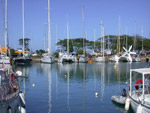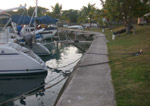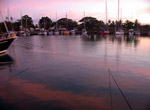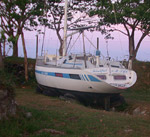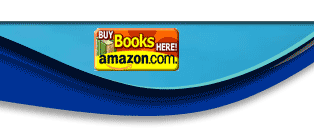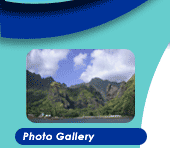October 31, 2002
|
Last night it all came out—the pent-up frustration and misery of putting Pacific Bliss up for storage—the incessant tropical heat and humidity. I stood there in the galley, sobbing my heart out, tears running down my face that I didn’t even bother to wipe away. I had held it in all day; one glass of wine in the evening was all it took to loosen the floodgates. I think it was a good thing—they say that the tear ducts need a good cleaning out now and then! The heat has been brutal in this sinkhole. Yes, it is an “approved” hurricane hole, nicely designed with a breakwater to the sea and a second breakwater separating the turning bay from the inner bay where we are. A huge bank—with yachts dug into the dirt, their hulls surrounded by tires—separates our cement-lined bay from the sea. The trade winds have been fluky with the change of the seasons from Fiji’s spring to summer. The last two days saw a slight breeze from the northwest, but it only passes over the top of us here in this hole. For the last two days we have sweated it out, our clothing sopped after only one hour of work. Gunter, and Dennis—who will watch over Pacific Bliss here—have made great progress on the outside: the main and jib have been taken down and neatly folded; the anchor has been removed so that the chain can be readily hooked up to the center buoy in the event of a hurricane; chains have been fastened to lines attached to the stern port and starboard cleats—with the entire med-moor system fastened to vertical railroad ties that have been dug deep into the bank; the dinghy and outboard have been covered; the instruments are capped. One of these days, the sail maker will arrive with the white tent that will be placed over the salon to cut the heat. A tarp will be attached to protect the trampoline from the ultraviolet rays. As for me, there’s no more luxuriating in the sunrise with my coffee while I catch up on my diary. The object of this week of torture is to begin each day’s projects early, while the sun is low. By noon, the sun is blazes mercilessly directly on the salon roof, raising temperatures inside over 100° F. By early afternoon, all work inside becomes impossible, and it is siesta time. I am engaged in a battle to protect Pacific Bliss and its contents from heat and mildew during the summer months when we will be gone. I’ve gone through every food locker and compartment—emptying it completely, disinfecting, wiping down, and using hundreds of sheets of Bounce to hopefully take up moisture and repel insects. Today, I tackled the stove, the galley utensil storage areas with all its rust stains, and emptied and cleaned the fridge. Last night we used the last of our fresh provisions. I am done cooking on board for the season—Thank God. After the meltdown, we decided that from now on, we quit working before we reach that point of utter exhaustion where even sleep becomes impossible! We realize that we’ve only touched on what Fiji can offer the cruiser. So we plan to “gunk hole” around Fiji for most of the next cruising season. Right now—of course, I’m anxious to go home to the temperate climate of San Diego. But as distressed as I am now, I already know in my heart of hearts that once there, I’ll be looking forward to embarking on Voyage III and our next cruising adventures. To remind us of what we will not miss, we made a reality checklist to use as we sit by the fireside dreaming about cruising: • No-nos (no-see-ums) Insect bites that itch for two days after the
attack that one does not usually feel at the time. We have to spray
ourselves whenever we go on shore or suffer disastrous consequences. • Rationing electricity and water. We will not miss the constant checking on whether the 8 solar panels made enough energy to run the fridge, the freezer, and the lights (or whether we have to run the engines to charge the batteries). And we won’t miss having to make more water to replenish every bottle we use. It certainly does make us more energy conscious when we are back home! Photos:
|
journal93.html |
|
|
